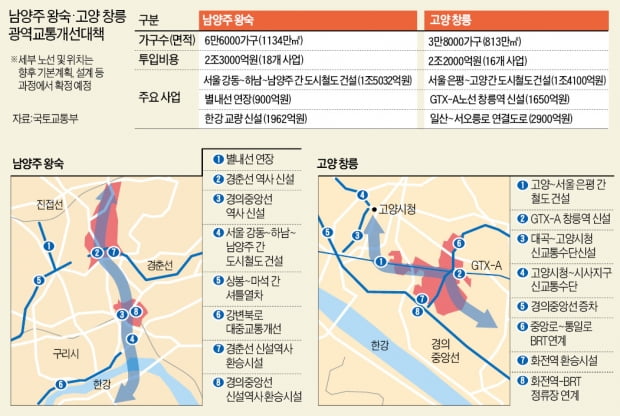The Wangsuk district in Namyangju, Gyeonggi Province and the Changneung district in Goyang are the first and second largest new cities, respectively. The government has decided to massively expand the metropolitan transportation network, including the addition of GTX (Seoul Metropolitan Rapid Transit Railway) stations, extension of subway line 9, and new construction of Goyang Line. When the project is completed, it is expected that the GTX will be able to travel to Seoul Station in 25 minutes from Wangsuk in Namyangju and 10 minutes from Changneung in Goyang. The accessibility to downtown Seoul and Gangnam is greatly improved, and it is expected to benefit not only the new city but also the surrounding area.
The Ministry of Land, Infrastructure and Transport announced on the 29th that it has confirmed measures to improve metropolitan transportation in Namyangju Wangsuk and Goyang Changneung after deliberation by the Metropolitan Transportation Committee.
▶Refer to page A4 of May 14th

Extension of line 9 to Wangsuk Namyangsuk
The Wangsuk district in Namyangju, consisting of two residential sites (districts 1 and 2), is the largest of the 3rd new period, with a scale of 1,134 million square meters. 66,000 households, 38% of the 173,000 households in the third new city, will be built. When the move-in is complete, more than 165,000 people will live, but there was no other transportation network plan except for the GTX-B line. This is why the government decided to extend Line 9 to significantly improve accessibility to Gangnam by investing a total of KRW 1.5 trillion.
Currently, Line 9 is scheduled to end by 2027 with a four-step extension (Seoul Central Veterans Hospital-Gangdong). Here, it was decided to increase Line 9 from Gangdong to Namyangju via Hanam. In Wangsuk 1 and 2 districts, the history of the Gyeongchun Line and the Gyeongui Jungang Line are also newly established. The GTX-B line can be transferred from Gyeongchun Line Station, which is newly entered in Wangsuk District 1. A plan was also prepared to extend the Byeolnae Line, an extension of Line 8, to meet the Jinjeok Line.
In addition to the subway, the ground road network will be expanded. Expand Olympic Highway and create a bypass road at Gangil Interchange (IC). It was decided to shorten the travel time between Wangsuk and Gangbyeon by about 30 minutes by introducing a bus passage system using a central separation zone on the north riverside road. It is also promoting the establishment of a new Han River bridge to disperse the traffic demand along the Han River. If traffic measures are implemented, the travel time from Wangsuk District to Seoul Station and 70 minutes to Gangnam Station is expected to be reduced to 25 minutes from Seoul Station and 45 minutes from Gangnam Station.
New Goyang Line and GTX stop in Changneung
In the Changneung district of Goyang (38,000 households), 2.2 trillion won is spent on 16 transportation projects. Of this, 1.4 trillion won will be spent on the construction of the urban railway (Goyang Line) connecting Eunpyeong-gu, Seoul and downtown Goyang. The Goyang Line is a line connecting Goyang City Hall from Saejeol Station of Subway Line 6.
New Changneung Station on the GTX-A line is also being promoted. It is to add a station between the previously planned Daegok Station and Yeonsinnae Station. The GTX-A route, which is already under construction, is scheduled to open in 2023. When you enter Changneung Station, you can commute to and from Seoul Station or Samseong Station at once without transferring.
To improve accessibility to Seoul, Seooreung-ro was expanded and Ilsan-Seooreung-ro connecting road was newly built. In order to diversify traffic demand, a new connecting road between Jungang-ro and the 2nd Free Road has been decided. The Ministry of Land, Infrastructure and Transport predicted that if such traffic measures are realized, the time required from Changneung District to Seoul Station will be reduced from 40 minutes to 10 minutes and from 50 to 25 minutes to Yeouido.
Gyosan and Gwacheon districts in Hanam, another 3rd new city, where measures to improve regional traffic were confirmed in May, are undergoing follow-up procedures such as starting a detailed design. From next year, the licensing procedure for each business will be promoted. An official from the Ministry of Land, Infrastructure and Transport said, “When Incheon Gyeyang and Bucheon Daejang districts receive the deliberation of the metropolitan area transportation committee on the 30th, the 3rd new city metropolitan transportation improvement measures will be completed.”
Variables such as project cost and resident backlash
The plan for the 3rd new city traffic countermeasures, in which LH (Korea Land and Housing Corporation) invests contributions for metropolitan transportation improvement, is confirmed through a preliminary feasibility study by public institutions. Compared to the financial business that considers economic feasibility, the process is on the quick side. However, it is questionable whether the project schedule will continue smoothly as announced by the government. This is because the project cost problem, resident backlash, and environmental problems may arise.
Even before the announcement of the 3rd new city, even the planned GTX line has been delayed due to increased resistance to residents over stationary stations in Gangnam and other areas. Jeong-Hoon Yoo, a professor of transportation system at Ajou University, said, “The Wirye Sinsa Line, the core transportation network of Wirye New Town, the second new city, was confirmed in 2008, but it will continue to be postponed. I will have to watch.”
Reporter Hyungjin Jeon/Hyunjoo Jang [email protected]
